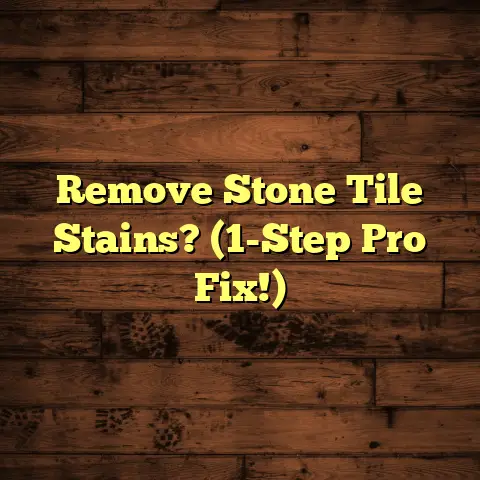Signs Of Water Damage In Wooden Structures? (Explained)
Smart living isn’t just about having the latest gadgets or energy-efficient appliances; it’s also about maintaining the integrity of our homes. One of the biggest threats to wooden structures—whether it’s your beautiful hardwood floors or the framing of your house—is water damage. I’ve seen firsthand how devastating it can be, and I’d like to share my insights on the signs of water damage in wooden structures.
Signs of Water Damage in Wooden Structures
As a flooring contractor with years of experience, I’ve encountered numerous projects where water damage has taken center stage. Let me share what I’ve learned about identifying these issues, from subtle signs to more obvious indicators.
1. Diminished Aesthetics: Discoloration and Stains
When I walk into a room and notice dark stains or discoloration on the wooden floors or walls, it raises red flags. These stains often indicate that water has infiltrated the wood, leading to mold growth or rot.
Tip: If you spot any discoloration, especially near windows, doors, or plumbing fixtures, it’s time to investigate further.
In one instance, I was called to a charming Victorian home where the owners had noticed dark spots appearing on their beautiful oak flooring. The homeowners were understandably concerned, as this was a significant investment for them. Upon closer inspection, I discovered that the water was seeping in through an improperly sealed window frame during heavy rains.
This experience taught me that even the most minor leaks can lead to significant issues if not addressed promptly.
2. Warping and Buckling
There was a project in a lovely home where I installed oak hardwood flooring. A few months later, the homeowner called me in a panic. The boards had started to buckle and warp. This was a clear signal of water damage. When wood absorbs moisture, it expands. If it cannot release that moisture, it can lead to serious structural problems.
Measurement Insight: A gap of 1/8 inch between boards is often acceptable, but if you notice gaps wider than this or boards that are visibly warped, immediate action is necessary.
In another case, I encountered a basement with engineered hardwood flooring that had been installed directly on a concrete slab. The homeowner had failed to use a moisture barrier beneath the flooring, and over time, moisture from the concrete seeped into the wood. The result? A buckled floor that looked more like waves than a solid surface.
I had to explain to the homeowner that not only would we need to replace the damaged flooring, but we also needed to address the underlying moisture issue before reinstalling anything.
3. Cracking and Splitting
I remember working on another job where the wooden beams in the basement were splitting apart. This was caused by prolonged exposure to moisture without proper ventilation. Cracks not only affect aesthetics but also weaken the structural integrity of the wood.
Advice: Regularly check wooden beams in damp areas like basements and crawl spaces for any signs of cracking.
In one particular home, I found extensive cracking in the support beams due to inadequate ventilation. The homeowner had converted their basement into a living space but had neglected to install vents. This led to moisture buildup and ultimately cracking in both the beams and the flooring above.
Addressing this issue required installing vents and dehumidifiers to manage humidity levels effectively. It was a challenging process, but seeing how grateful the homeowners were when we resolved their issues made it worthwhile.
4. Mold and Mildew Growth
Mold doesn’t just look bad; it can also pose health risks. I once worked on a project where the homeowners noticed a musty smell coming from their living room. Upon inspection, I found mold growing on their wooden furniture and walls—a sure sign of water damage somewhere in the house.
Actionable Tip: If you see mold, it’s crucial to address the water source first before attempting any cleanup.
When I investigated further, I discovered that a leak from an upstairs bathroom was causing water to drip down into the living room ceiling. The homeowners were shocked; they had no idea that such a small leak could lead to mold growth throughout their living space.
Once we fixed the leak, I guided them through cleaning up the mold with appropriate products and techniques to ensure their home was safe again.
5. Soft or Spongy Spots
When walking on a wooden floor, if you feel any soft or spongy spots, that’s often an indicator that water has compromised the wood. I’ve had homeowners express surprise when they discovered soft spots in high-traffic areas.
Recommendation: Don’t ignore these areas. They could indicate that the subfloor is also damaged and might need replacement.
During one project, I was installing new flooring in a kitchen when I noticed some spongy spots near the sink area. Upon further inspection, I realized that water had been leaking from an old plumbing fixture for quite some time, degrading both the subfloor and the hardwood above.
We had to remove several boards and replace sections of the subfloor before we could continue with installation. It was an unexpected setback but ultimately necessary for ensuring a long-lasting floor.
6. Musty Odors
One thing I’ve learned over the years is that a musty smell should never be ignored. It often indicates hidden moisture problems, especially in wooden structures. When I inspected one house, the smell was prevalent in the basement, prompting me to investigate further.
Tip: Look for leaks around plumbing fixtures and check for condensation issues as potential sources of moisture.
In this case, we discovered that condensation from a poorly insulated duct system was creating excess moisture in the basement air. Once we addressed insulation issues and improved airflow with additional vents, the musty smell dissipated significantly.
7. Visible Water Marks
During one project, I noticed water marks on the ceiling below a bathroom. This was a clear indication that there was a leak from above, likely from the plumbing or shower area.
Actionable Insight: Water marks are a direct visual cue that something needs attention; ignoring them can lead to more extensive damage.
When I brought this issue to the homeowner’s attention, they were surprised because they had seen no visible signs of leaks in their bathroom. However, after investigating, we found that a small crack in the shower drain was causing slow but steady water leakage over time.
After making repairs and repainting the ceiling, it was satisfying to see how quickly things returned to normal for them.
Addressing Water Damage
So what do you do when you spot these signs? Here are some steps based on my experiences:
- Identify the Source of Moisture:
Check for leaks in plumbing, roofs, or windows. - Repair Any Leaks Immediately:
Don’t let small leaks turn into big problems. - Dry Out Affected Areas:
Use fans and dehumidifiers to remove excess moisture from the air and surfaces. - Inspect for Structural Damage:
Depending on severity, you may need professional help for repairs. - Consider Replacement:
If the damage is extensive, replacing affected boards may be necessary.
Cost Estimation with FloorTally
In my flooring projects, accurate cost estimation is essential for staying within budget. That’s where FloorTally comes into play. It helps me quickly calculate material costs based on local rates and allows me to factor in potential waste from damaged areas.
For instance, if I’m working on a living room that requires 400 square feet of hardwood flooring but discover water-damaged areas totaling 50 square feet, FloorTally helps me adjust my estimates seamlessly. I can provide clients with an updated budget before we even start replacement work.
Recently, I worked on a project where water damage extended beyond what we initially estimated. Thanks to FloorTally’s ability to quickly reassess costs based on real-time data, I was able to communicate effectively with my client about necessary adjustments without any surprises.
The Importance of Maintenance
Preventing water damage is often about maintenance. Regular checks can save homeowners from costly repairs down the line.
- Gutters: Ensure gutters are clean and direct water away from your home.
- Humidity Levels: Keep humidity levels below 60% inside your home.
- Sealants: Regularly check seals around windows and doors.
- Ventilation: Ensure areas like basements and attics are well-ventilated.
I recall one winter when heavy snow caused ice damming on a roof in one of my clients’ homes. The water backed up under shingles and began seeping into eaves and walls—an expensive problem that could have been avoided with proper maintenance of gutters before winter weather hit.
Repairing Water Damage
If you find yourself facing water damage after identifying those signs, here’s how you can effectively tackle repairs:
Assessing Damage Extent
- Start by evaluating how deep the damage goes.
- Check if it’s limited to surface-level issues or if it has penetrated deeper layers like subfloors or beams.
- In one case, I found extensive rot in floor joists beneath beautiful oak flooring that looked fine from above but was compromised underneath due to long-term moisture exposure.
Removing Affected Materials
- If certain areas are beyond repair (like severely warped or rotting boards), it’s best to remove them entirely.
- Make sure you wear protective gear such as gloves and masks when dealing with moldy materials.
- In another instance, I had to remove sections of flooring around a toilet leak—what started as a small repair escalated quickly into replacing entire sections of both subflooring and finished hardwood due to contamination.
Drying Out Spaces
- Use fans and dehumidifiers to dry out affected areas thoroughly.
- This step is critical—if you don’t eliminate moisture entirely before proceeding with repairs or replacements, you risk future mold growth.
- After cleaning up after a flood in one client’s basement, we set up multiple dehumidifiers for days until everything was completely dry before starting repairs.
Replacing Damaged Materials
- Use high-quality replacement materials that are resistant to future moisture issues.
- Consider using engineered wood products in areas prone to high humidity or moisture exposure.
- I once had clients who wanted solid hardwood installed near their kitchen but settled for engineered hardwood instead after discussing its benefits regarding moisture resistance—this turned out to be a wise choice when they later experienced minor leaks during renovations!
Preventive Measures
After addressing existing water damage issues effectively, implementing preventive measures is key:
- Install Moisture Barriers:
- For basements and crawl spaces especially.
- This helps keep excess moisture at bay.
- Proper Ventilation:
- Ensure attics and crawl spaces have adequate airflow.
- This can greatly reduce humidity levels indoors.
- Routine Inspections:
- Schedule regular inspections of your home’s plumbing systems.
- Check roofs for damage after severe weather events.
- Water Alarms:
- Consider installing water alarms near potential leak sources like washing machines or water heaters—these can alert you before major damage occurs!
I recall fitting one client’s house with multiple water alarms near bathrooms after they experienced minor leaks; they were thrilled when these alerts saved them from more significant problems down the line!
Conclusion
Water damage can be sneaky and often shows itself in subtle ways before becoming a major issue. By knowing what signs to look out for, you can protect your wooden structures and maintain their integrity for years to come.
Remember to act fast when you spot any warning signs, as addressing issues early can save both time and money in the long run. Stay vigilant and keep your home healthy!





